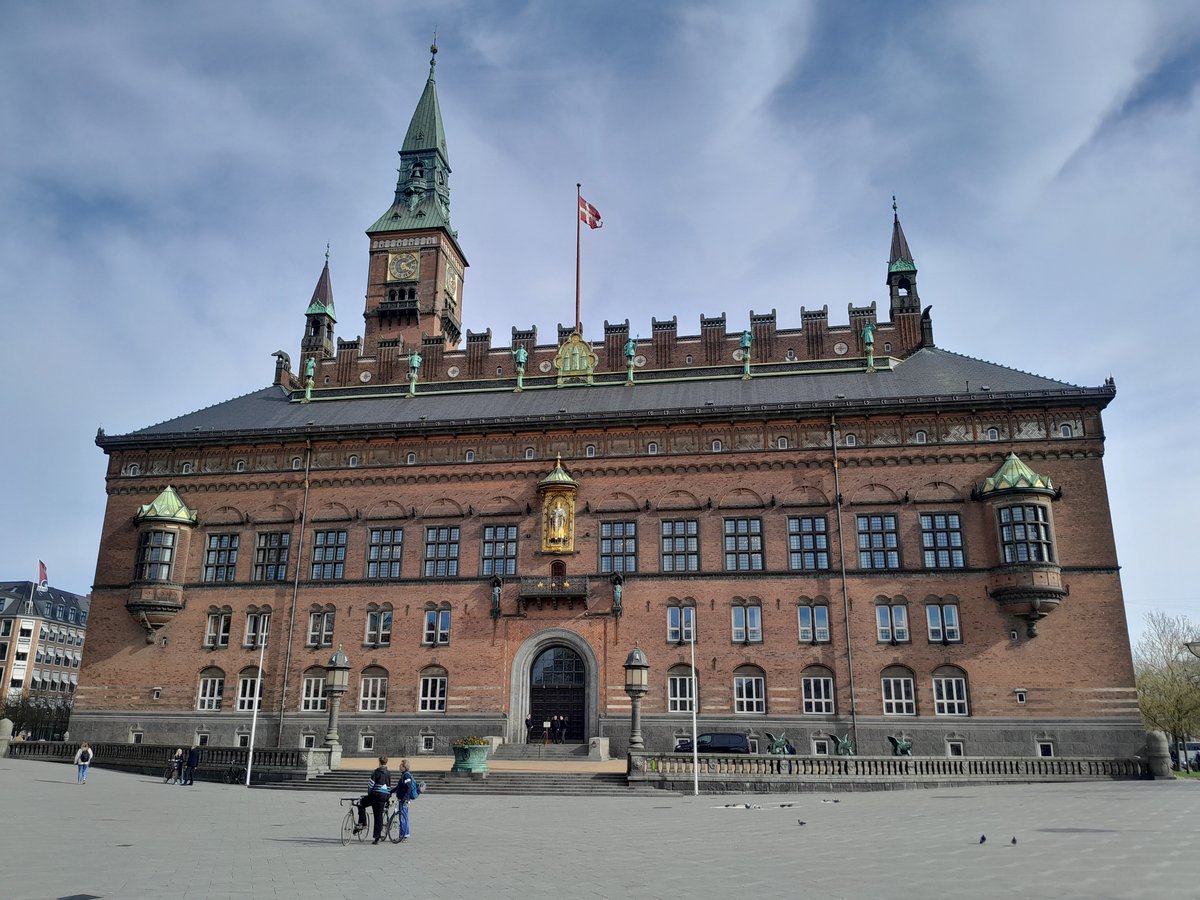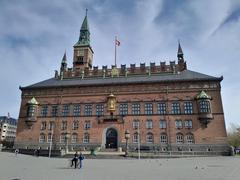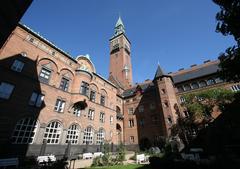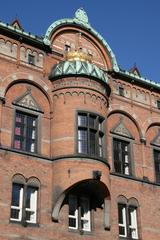
Visiting Copenhagen City Hall: Hours, Tickets, and Historical Sites in Copenhagen
Date: 14/06/2025
Introduction
Copenhagen City Hall (Københavns Rådhus) stands as a majestic symbol of Denmark’s capital, uniting rich historical traditions with striking National Romantic architecture and vibrant civic life. Completed in 1905, this iconic building is the third city hall on its site at Rådhuspladsen (City Hall Square), reflecting Copenhagen’s journey from a medieval trading center to a modern metropolis. Designed by Martin Nyrop, the City Hall is inspired by northern Italy’s medieval city halls—especially the Palazzo Pubblico in Siena—while celebrating uniquely Danish motifs and craftsmanship.
This guide provides all essential information for visiting Copenhagen City Hall, including current opening hours, ticketing options, accessibility details, and highlights of its history and architecture. Whether you are a history enthusiast, architecture lover, or an inquisitive traveler, this article equips you with practical tips and insights to make the most of your visit to this landmark of Danish heritage (VisitCopenhagen, dac.dk, Nomade Epicureans).
Table of Contents
- Origins and Early Development
- Architectural Vision and Design
- Visiting Copenhagen City Hall: Hours, Tickets, and Accessibility
- Getting There and Nearby Attractions
- Historical Significance and Civic Role
- Preservation and Modern Adaptation
- Symbolism and Cultural Impact
- Notable Events and Milestones
- Architectural Details and Artistic Features
- Tips for Visitors
- Frequently Asked Questions (FAQ)
- Contact and Practical Information
- Conclusion and Final Tips
- References
Origins and Early Development
The present Copenhagen City Hall is the third iteration of a city hall at this site, reflecting centuries of civic evolution. The earliest city hall appeared in the 15th century, when Copenhagen was growing as a political and trading hub. Successive buildings replaced their predecessors due to fire or the city’s changing needs, with the current structure built between 1892 and 1905. The new city hall was intended both as an administrative center and a bold statement of Copenhagen’s modern ambitions (VisitCopenhagen).
Architectural Vision and Design
Martin Nyrop’s winning design in the 1888 competition championed the National Romantic style, blending Danish medieval and Renaissance traditions with local materials and craftsmanship. The red brick façade, the 105.6-meter clock tower, and ornate detailing make the City Hall a signature of Copenhagen’s skyline (ArchDaily, dac.dk).
Nyrop drew clear inspiration from the Palazzo Pubblico in Siena, seen in the clock tower’s asymmetrical placement and the building’s overall profile (wikipedia). However, the City Hall’s decorative program is distinctly Danish, celebrating local folklore, flora, and fauna.
Visiting Copenhagen City Hall: Hours, Tickets, and Accessibility
-
Opening Hours:
Monday–Friday: 09:00–16:00
Saturday: 09:30–13:00
Sunday: Closed
(Check for holiday or special event changes on the official visitor site) -
Admission:
Free to the main hall and public areas.
Guided tours and tower access require tickets. -
Guided Tours:
Tours are available in Danish and English, lasting 45–60 minutes and granting access to otherwise restricted rooms like the city council chamber.- Ticket Price: ~60 DKK per person (Nomade Epicureans)
- Booking: On-site or online
- Tower Visits:
Monday–Friday: 11:00–14:00, guided only, 30 DKK per person. Tower climb involves 300+ steps and is not wheelchair accessible.
-
Accessibility:
The main floor and public spaces are wheelchair accessible, with ramps and elevators. The clock tower and some upper floors are accessible only by stairs.
Getting There and Nearby Attractions
Copenhagen City Hall’s central location on Rådhuspladsen makes it easily accessible:
- Metro: Rådhuspladsen Metro (M3 City Circle Line)
- Train: Copenhagen Central Station (København H) is a 5–10 minute walk
- Bus: Multiple lines stop nearby (Scandiculture)
Nearby attractions:
- Tivoli Gardens: Historic amusement park just next to City Hall
- Strøget: Europe’s longest pedestrian shopping street
- National Museum of Denmark: A short walk away
- Christiansborg Palace: Denmark’s parliament and royal reception rooms
Historical Significance and Civic Role
Since its inauguration in 1905, City Hall has been the seat of Copenhagen’s municipal government, housing the Lord Mayor’s office, City Council chamber, and various departments. It hosts major civic events, including royal receptions, state visits, and public celebrations such as Copenhagen Pride and New Year’s Eve festivities. The City Hall’s central location ensures its ongoing role as a backdrop to demonstrations, parades, and urban life (VisitCopenhagen).
A highlight is Jens Olsen’s World Clock, a remarkable astronomical clock completed in 1955 after 27 years of work. With over 14,000 moving parts, it tracks time and astronomical phenomena with extraordinary accuracy (Nomade Epicureans).
Preservation and Modern Adaptation
City Hall has undergone multiple restoration projects to preserve its historic character while adapting to contemporary needs. Recent refurbishments focus on sustainability, accessibility, and integration of new technologies, aligning with Copenhagen’s ambition to be the world’s first CO2-neutral capital by 2025 (ArchDaily). These efforts ensure the building remains both a living government headquarters and a welcoming destination for visitors.
Symbolism and Cultural Impact
Copenhagen City Hall is a civic symbol, representing democratic values and national identity through its architecture and public functions. The building’s decorative program references Danish folklore, with motifs of native animals and legendary figures. The prominent gilded statue of Bishop Absalon above the entrance underscores the building’s role as guardian of Copenhagen’s spirit (introducingcopenhagen.com).
Rådhuspladsen, in front of the City Hall, is a vibrant urban space for public gatherings, rallies, and celebrations (truescandinavia.com).
Notable Events and Milestones
Copenhagen City Hall has witnessed numerous historic events:
- Announcements of Danish sovereignty and hosting foreign dignitaries
- Annual Hans Christian Andersen Literature Award presentations
- Public celebrations after international sports victories
- Official New Year’s Eve addresses delivered from the City Hall balcony
Architectural Details and Artistic Features
- Façade: Red brick in National Romantic style, inspired by Italian Renaissance and Danish medieval architecture
- Clock Tower: 105.6 meters (346 feet) tall, with panoramic city views (wikipedia)
- Main Hall: Glazed roof, Italianate wall decorations, mosaics, and busts of notable Danes (Thorvaldsen, Andersen, Bohr)
- Jens Olsen’s World Clock: A mechanical marvel with 14,000+ moving parts (introducingcopenhagen.com)
Tips for Visitors
- Best Time: Early mornings or weekdays for fewer crowds
- Photography: Allowed in most public areas (no flash during events)
- Combine Your Visit: Explore nearby Tivoli Gardens, Strøget, or the National Museum
- Facilities: Restrooms and cloakroom available; accessible entrances for wheelchairs
Frequently Asked Questions (FAQ)
Q: What are the opening hours of Copenhagen City Hall?
A: Monday–Friday 09:00–16:00, Saturday 09:30–13:00, Sunday closed.
Q: Is there an entry fee?
A: Entry to the main hall is free. Guided tours (~60 DKK) and tower access (30 DKK) are ticketed.
Q: Is City Hall wheelchair accessible?
A: The main floor is accessible; the tower and some upper floors are not.
Q: Are guided tours available?
A: Yes, in English and Danish. Advance booking is recommended.
Q: Can I climb the clock tower?
A: Yes, via guided tour only (over 300 steps; not suitable for all).
Q: Are there special events at City Hall?
A: Yes, including public ceremonies, exhibitions, and civic celebrations. See the event calendar.
Contact and Practical Information
| Feature | Details |
|---|---|
| Location | Rådhuspladsen 1, 1550 København V |
| Opening Hours | Mon–Fri: 09:00–16:00; Sat: 09:30–13:00; Sun: Closed |
| Entry Fee | Free (main hall); 60 DKK (guided tour); 30 DKK (tower) |
| Guided Tours | Daily, see schedule |
| Tower Access | Mon–Fri: 11:00–14:00, guided only |
| Accessibility | Main floor accessible; tower not wheelchair accessible |
| Nearby Attractions | Tivoli Gardens, Strøget, National Museum of Denmark, Christiansborg Palace |
| Public Transport | Metro: Rådhuspladsen; Train: Central Station; Bus: H.C. Andersens Blvd. |
| Contact | [email protected], +45 70 22 24 42 |
Conclusion and Final Tips
Copenhagen City Hall is a living monument to the city’s historical progress, architectural innovation, and civic engagement. With free main hall access, multilingual guided tours, and a strategic location at the heart of Copenhagen, it is an essential stop for anyone interested in Danish culture and history. Plan your visit in advance, particularly for guided tours and tower access, and combine your trip with other nearby attractions for a fulfilling experience.
For the latest updates, virtual tours, and travel tips, consult official resources and download the Audiala app for on-site guided content. Embark on your journey to discover Copenhagen City Hall’s architectural grandeur and historical significance, and stay inspired for your Danish adventures.
References and Further Reading
- Copenhagen City Hall Visiting Hours, Tickets, and History Guide, 2024, VisitCopenhagen (VisitCopenhagen)
- Refurbishment Reviving Historic Copenhagen with Modern Design, 2024, ArchDaily (ArchDaily)
- Copenhagen City Hall - Danish Architecture Center, dac.dk (dac.dk)
- Copenhagen City Hall - Introducing Copenhagen (introducingcopenhagen.com)
- Copenhagen City Hall - Wikipedia (wikipedia)
- Guided Tour at Copenhagen City Hall, 2024, visitorservice.kk.dk (visitorservice.kk.dk)
- The 10 Most Famous Monuments in Copenhagen, 2024, truescandinavia.com (truescandinavia.com)
- 2 Days in Copenhagen - Nomade Epicureans Travel Guide (Nomade Epicureans)
- Copenhagen City Hall Visit Guide, Scandiculture (Scandiculture)



























































































